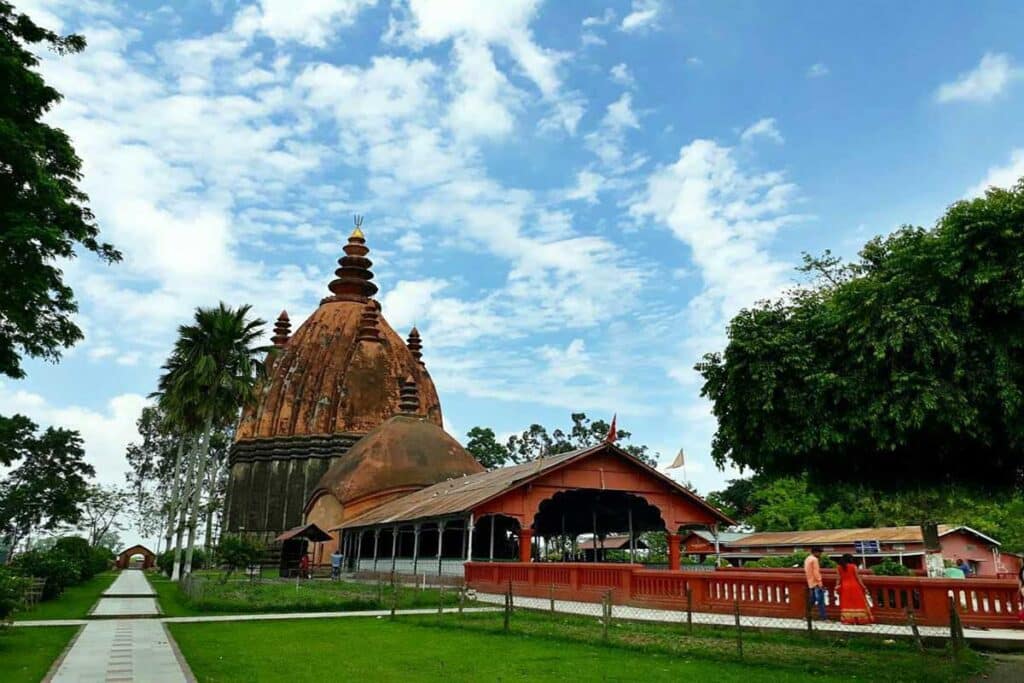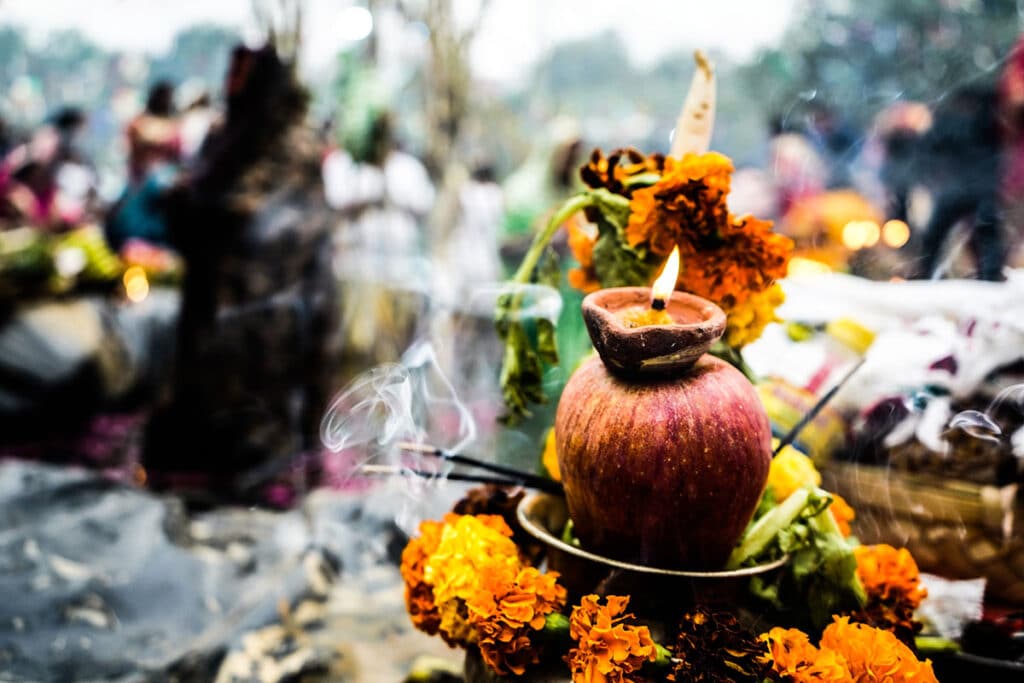Introduction
Assam undoubtedly exudes a timeless charm with its rich history and culture. Its landscape is peppered with an array of ancient temples and monuments that showcase its awe-inspiring heritage. These temples, steeped in mythology, are held sacred by the locals and bear witness to the state’s cultural and religious diversity.
The Vaishnava tradition is a prominent feature of Assam’s religious landscape, where Lord Vishnu and his avatars are venerated with utmost devotion. This tradition owes its origins to the medieval saints Sankardeva and Madhavdeva, who left an indelible imprint on the state’s religious and cultural ethos.
Assam’s treasure trove of ancient Hindu temples, dating back to the medieval era, offers glimpses of the state’s rich past. Each temple boasts a unique historical and cultural significance that has been passed down through generations. In this blog, we have mentioned some of the sacred temples in Assam.
1. Kamakhya Temple

Kamakhya Temple, an ancient Shakti Peetha and one of India’s oldest among the 51 are situated on Nilachal Hill in the western part of Guwahati, Assam. The main temple is surrounded by ten individual shrines dedicated to the Mahavidyas, including Kali, Tara, and Bhairavi. It is a popular hub for Tantra worship and attracts thousands of devotees every year during Ambubachi Mela, Manasha Puja, and Navaratri in the autumn.
2. Umananda Temple
The Umananda Temple is a sacred site dedicated to Lord Shiva, located on the small river island of Umananda in the Brahmaputra River flowing through Guwahati, Assam. The island is also known as Peacock Island for its shape, and it is believed to have been created by Lord Shiva for Parvati’s delight. The island has other names, such as Bhasmachal, and is associated with the legend of Shiva burning Kamadeva with his third eye. The temple is particularly revered on Maha Shivaratri and Mondays, and devotees can reach the island through a ferry from Umananda or Kachari Ghat
3. Tilinga Mandir
Tilinga Mandir, a famous temple dedicated to Lord Shiva in Upper Assam, is located in the small town of Bordubi, 7 kilometres from Tinsukia District. This temple is also known as the “Temple of Bells” or “Tilinga Mandir” due to its extensive collection of bells, which made it to the Limca Book of World Records. If someone ties a bell to the banyan tree at Tilinga Mandir, which emerged in 1965 and where a Shiva Lingam appeared, it is believed that has the power to make the wishes come true. Pilgrims visit this temple throughout the year, and Monday is the most popular day.
4. Negheriting Shiva Doul
The Negheriting Shiva Doul, a temple complex consisting of a beautifully decorated Shiva Doul and four smaller Douls dedicated to Ganesh, Vishnu, Durga, and Surya, is located approximately 1.5 kilometres north of National Highway 37 in the Golaghat district of Assam. The temple was originally built by the Kachari ( COMMUNITY) in the 8th–9th century AD, and the current temple was reconstructed by the Ahom king Rajeswar Singha after multiple natural calamities.
5. Siva Dol

The Siva Dol, located on the banks of the Borpukhuri in the heart of Sivasagar, is a group of three Hindu temples, including the Siva Dol, Vishnu Dol, and Devi Dol shrines, as well as a museum. The temple dedicated to Lord Shiva stands tall at 104 feet, with a base measuring 195 feet in circumference and an 8-foot-high golden dome on top. The temple hosts a huge fair during Mahashivaratri and attracts pilgrims from all over India for the Hare Krishna kirtan, which is conducted throughout the night during the Hindu month of Savan. The Vishnu Dol celebrates Dol Yatra and Rath Yatra annually, while Devidol celebrates Durga Puja with great fervour in September-October.
6. Kedareswara Temple
The Kedareswar temple is situated atop Madanchala Hillock in Hajo, Assam. This medieval shrine was built by Ahom King Rajeswar Singha in 1753 and is a rare Svayambhu linga in the Ardhanarishwara form of Lord Shiva. The linga is so sacred that it is kept covered by a metal bowl by the priests and is not visible to the devotees.
7. Asvakranta Temple
The Asvakranta Temple is an important shrine of Lord Vishnu situated on a rocky bed near the Brahmaputra River in the north of Guwahati. The deity worshipped here is Anantasyeyin Vishnu, depicting the lord sitting on the serpent. According to legend, Lord Krishna halted here with his army and horses before defeating the demon Narakasur, who ruled over this region. A visit to this temple is believed to absolve one of all sins and help one attain salvation.
8. Basistha Temple
The Basistha Temple, a Shiva temple located inside the Basistha Ashram, a historic location thought to be the residence of the sage Basistha, was constructed in 1764 by Ahom King Rajeswar Singha and is in the southeast (ARN) corner of Guwahati. The temple stands beside mountain streams that emerge from the Meghalaya hills and eventually become the rivers Basistha and Bahini/Bharalu. While the sage’s meditation cave is located 5 km away, the temple is a popular place of worship.
9. Bhairabi Temple
The Bhairabi Temple is in Kolibari, on the outskirts of Tezpur, in Assam, and is regarded as a sidhapitha where individuals seek blessings from Maa Bhairabi to fulfil their desires. According to legend, the daughter of the mighty Asura King Banasura, Usha, worshipped the Goddess here regularly. The Durga Puja festival is celebrated in grand style at this temple, and animal sacrifices, including goats, ducks, pigeons, and other creatures, are still conducted frequently.
10. Ugra Tara Temple
The Ugra Tara Temple is a significant shrine dedicated to Devi Tara, located in Latasil, in the western part of Jur Pukhuri. According to legend, the temple is associated with the navel of Sati, the first consort of Lord Shiva. Ahom King Siva Singha erected the present temple in 1725 AD, and the Kalika Purana describes it as a Shakti peetha named Dikkaravasini. The temple has a unique feature, as the garbhagriha does not have any image or idol of Ugra Tara, but a small pit filled with water is considered the Goddess. The temple also has a Shivalaya beside it and a pond behind it.
11. Maha Bhairav Temple

The Maha Bhairav Temple, located on a hillock in the northern part of Tezpur, Assam, is a temple dedicated to Lord Shiva, founded by King Bana in prehistoric times. The temple was originally constructed with stone but was later renovated and reconstructed with concrete. The festival of Maha Shivaratri is celebrated with great enthusiasm, and devotees visit the temple from far and wide to offer laddus laced with bhang to Lord Shiva. The temple also has a ritual of releasing pigeons, symbolizing the liberation of the spirits of ancestors.
12. Tamresveri Temple
Tamresveri Temple, situated in the northern Lakimpur district of Assam near Sadiya, is a unique single-stone structure held together by iron pins without any clamps. Despite its deteriorating condition in forests, the temple boasts stunning sculpted images of animals, birds, flowers, and geometrical designs inside.
13. Navagraha Temple
The Navagraha Temple, located on Chitrachal hill in southeastern Guwahati, is devoted to the nine major celestial bodies of Hindu astronomy, including the Sun, Moon, Mars, Mercury, Jupiter, Venus, Saturn, the North Lunar Node, and the South Lunar Node. It serves as a research centre for both astrology and astronomy and was rebuilt after an earthquake destroyed part of its tower and structure.
14. Da Parbatia Temple
Da Parbatia Temple is an ancient Hindu temple located in the village of Da Parbatia, a few kilometres west of Tezpur city in Assam. Known for its impressive architecture, the temple is one of the oldest in Assam and features exquisite sculptural art in the ruins of its door frame. Under the Ancient Monuments and Archaeological Sites and Remains Act 1958, it is of great historical significance and is overseen by the Archaeological Survey of India. The temple’s ruins were constructed during the Ahom era and are built over the foundation of an ancient temple, with a stone-paved layout plan of the sanctum sanctorum and a mandapa.
15. Sukreswar Temple
The Sukreswar Temple is a temple dedicated to Lord Shiva and was constructed in 1744 on Sukreswar (or Itakhuli Hill) in Guwahati. It is funded by King Rajeswar Singha and boasts a stunning view of the Brahmaputra River and Umananda Island, the world’s smallest river island. Visitors can also witness various activities on the river, such as boat sailing, puja ceremonies, and bathing.
16. Hayagriva Madhava Temple
Located in Hajo, about 30 km west of Guwahati, the Hayagriva Madhava Temple is a holy site for Hindus, Buddhist Lamas, and Bhutiyas. This temple is famous for its exquisite image of Lord Vishnu, and it is believed that Lord Buddha attained Nirvana or Moksha at this place. The temple’s entrance is a beautifully carved granite block structure with colossal, sculpted figures of the 10 Avatars adorning the exterior. Festivals such as Doul, Bihu, and Janmashtami are celebrated here every year with great enthusiasm.
17. Mahamaya Temple
The Mahamaya Temple, located in the Kokrajhar District of Assam, is a significant Shakti Peetha and a popular tourist attraction. Visitors can witness the temple’s 400-year-old tradition of animal sacrifice, especially during Durga Puja. The temple also houses a magnificent idol of Goddess Kali and Lord Hanuman. In addition, the Mahamaya Snaanghat Temple, located a few kilometres away, is another place of worship associated with the Mahamaya goddess, where a Shakti Yagya is performed every year in January.
Conclusion
We hope that you enjoyed reading our blog on the 18 most sacred temples in Assam. These temples showcase some of the finest specimens of medieval architecture and boast intricate carvings that celebrate Assam’s rich cultural heritage. If you live in Guwahati or visit Guwahati, don’t forget to check out as many of them as possible. From Vaishnav to Shiva temples, you’ll be amazed by the grandeur and beauty of these ancient monuments.

